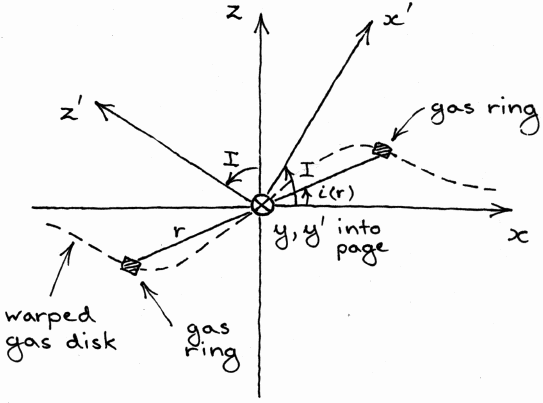
Figure: 1
A disk galaxy typically appears flat at visible wavelengths, where the observed light traces the position of stars, particularly young O and B stars. At radio wavelengths, where the observed radiation traces the position of gas (e.g. neutral hydrogen), many galaxies display a warp. Figure 1 illustrates what a warp looks like when viewed edge-on. The disk of the galaxy turns up at one edge and down at the other, just like the brim of a sombrero hat.

Figure: 1
Warped disks are common. For example, all of the spiral galaxies in our Local Group (the Milky Way, Andromeda, and M33) are warped. At the same time, noone really knows what causes a warp to develop. The aim of this problem is to analyse one plausible theory that has been advanced recently.
Suppose we model a disk galaxy as a combination of an infinite disk and an infinite halo of stars. Both the disk and the halo are assumed to be cylindrically symmetric. However, their axes of symmetry are misaligned, as shown in Figure 2 (edge-on view). The disk is symmetric about the z axis, while the symmetry axis z' of the halo is inclined to the z axis by an angle I.

Figure: 2
Now consider a thin ring of gas, of radius r, inclined at an angle i to the x axis as shown in Figure 3.

Figure: 3
In general, the nonspherical geometry of the system implies that there is a nonzero net torque acting on the gas ring. Nevertheless, it turns out that, for every value of r, there is a value of i, written as i(r), for which the net torque acting on the gas ring vanishes, because the torque exerted by the halo exactly cancels the torque exerted by the disk. The gas collects at the positions where the torque vanishes, forming a stable configuration. We calculate the shape of the configuration, i(r), in this problem.
The first step in the calculation is to calculate the
gravitational acceleration ![]() due to the halo
at an arbitrary point
due to the halo
at an arbitrary point ![]() . For this,
we need to assume a gravitational potential for the halo
that is cylindrically symmetric about the z' axis.
One such simple potential is
. For this,
we need to assume a gravitational potential for the halo
that is cylindrically symmetric about the z' axis.
One such simple potential is
![]()
where ![]() and
and ![]() are constants describing
the central potential and characteristic radius of the
halo respectively, and q is a geometric factor.
are constants describing
the central potential and characteristic radius of the
halo respectively, and q is a geometric factor.

![]()
The second step in the calculation is to calculate the
gravitational acceleration ![]() due to the disk
at an arbitrary point
due to the disk
at an arbitrary point ![]() .
We assume that the disk has
infinite diameter, zero thickness, and surface mass density
.
We assume that the disk has
infinite diameter, zero thickness, and surface mass density
![]() (units:
(units: ![]() ).
).
![]()
with the plus sign for z<0 and the minus sign for z>0. (Hint: for a Gaussian surface, you may wish to use a cylinder of height 2z and cross-sectional area A bisected horizontally by the disk.)
The third step in the calculation is to calculate the
torque per unit mass, ![]() ,
exerted by the disk and halo on a gas ring of radius r
and inclination i, shown in Figure 3.
,
exerted by the disk and halo on a gas ring of radius r
and inclination i, shown in Figure 3.
![]()
where
![]()
and
![]() is the total gravitational acceleration due to disk and halo.
is the total gravitational acceleration due to disk and halo.


We are finally in a position to calculate the shape of the warp of the galactic gas. Recall that the shape of the warp is described by the variation of the inclination angle i(r) as a function of radius r.
![]()